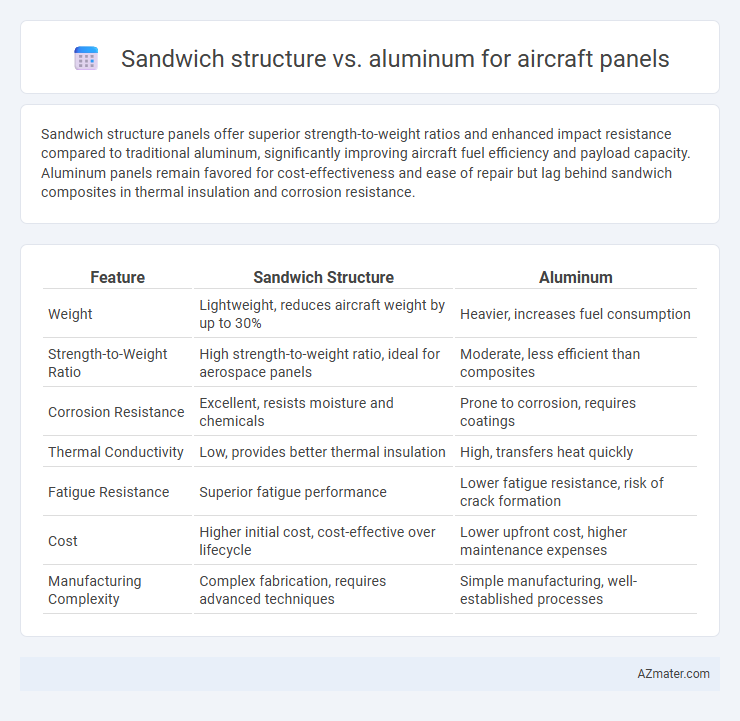Sandwich structure panels offer superior strength-to-weight ratios and enhanced impact resistance compared to traditional aluminum, significantly improving aircraft fuel efficiency and payload capacity. Aluminum panels remain favored for cost-effectiveness and ease of repair but lag behind sandwich composites in thermal insulation and corrosion resistance.
Table of Comparison
| Feature | Sandwich Structure | Aluminum |
|---|---|---|
| Weight | Lightweight, reduces aircraft weight by up to 30% | Heavier, increases fuel consumption |
| Strength-to-Weight Ratio | High strength-to-weight ratio, ideal for aerospace panels | Moderate, less efficient than composites |
| Corrosion Resistance | Excellent, resists moisture and chemicals | Prone to corrosion, requires coatings |
| Thermal Conductivity | Low, provides better thermal insulation | High, transfers heat quickly |
| Fatigue Resistance | Superior fatigue performance | Lower fatigue resistance, risk of crack formation |
| Cost | Higher initial cost, cost-effective over lifecycle | Lower upfront cost, higher maintenance expenses |
| Manufacturing Complexity | Complex fabrication, requires advanced techniques | Simple manufacturing, well-established processes |
Introduction to Aircraft Panel Materials
Sandwich structures in aircraft panels combine lightweight cores with strong face sheets, offering superior stiffness-to-weight ratios compared to traditional aluminum panels. Aluminum has been favored for its durability, corrosion resistance, and ease of fabrication but often results in heavier components. Modern aircraft increasingly adopt sandwich panels to reduce overall weight while maintaining structural integrity and improving fuel efficiency.
Overview of Sandwich Structures
Sandwich structures in aircraft panels consist of two thin, strong face sheets bonded to a lightweight core, typically made from materials like honeycomb or foam, providing high stiffness-to-weight ratios compared to solid aluminum panels. This configuration enhances impact resistance, vibration damping, and thermal insulation while significantly reducing overall weight, leading to improved fuel efficiency and performance in aerospace applications. Aluminum remains popular for its durability and ease of repair, but sandwich structures are increasingly favored for panel applications where weight savings and structural efficiency are critical.
Properties of Aluminum Panels
Aluminum panels for aircraft offer exceptional strength-to-weight ratios, corrosion resistance, and excellent fatigue performance, making them a popular choice in aerospace applications. Their high thermal conductivity and ease of fabrication allow for efficient manufacturing and repair processes. Despite being heavier than sandwich structures, aluminum panels provide superior structural integrity under dynamic stresses commonly experienced during flight.
Weight Comparisons: Sandwich vs Aluminum
Sandwich structures in aircraft panels typically offer significant weight savings compared to traditional aluminum, with core materials such as honeycomb or foam dramatically reducing overall mass while maintaining strength and stiffness. These composites can be up to 30-50% lighter than aluminum panels, enhancing fuel efficiency and payload capacity. The optimized strength-to-weight ratio of sandwich structures is crucial for aerospace applications where minimizing weight directly impacts performance and operational costs.
Structural Strength and Stiffness
Sandwich structures in aircraft panels provide superior stiffness-to-weight ratios compared to aluminum, significantly enhancing structural performance while reducing overall weight. The core material, often honeycomb or foam, combined with composite face sheets, distributes loads efficiently, resulting in increased resistance to bending and buckling. Aluminum panels, while strong and ductile, typically require greater thickness to achieve similar stiffness, leading to higher weight and potentially reduced fuel efficiency.
Fatigue and Durability Performance
Sandwich structures, consisting of lightweight core materials bonded between metal or composite face sheets, exhibit superior fatigue resistance and durability compared to traditional aluminum panels in aircraft applications. The energy absorption and stress distribution capabilities of sandwich panels enhance their ability to withstand cyclic loading without significant degradation. Aluminum panels, while offering excellent strength-to-weight ratios, tend to suffer from fatigue crack initiation and propagation under repetitive stress, reducing long-term performance in high-fatigue environments.
Thermal and Acoustic Insulation Capabilities
Sandwich structures offer superior thermal and acoustic insulation compared to traditional aluminum panels due to their composite layers, which include insulating cores such as foam or honeycomb, reducing heat transfer and dampening sound vibrations effectively. Aluminum panels, while lightweight and strong, have high thermal conductivity and poor sound absorption, making them less efficient in insulating aircraft cabins from temperature variations and external noise. The enhanced insulation properties of sandwich panels contribute to improved passenger comfort and energy efficiency in aerospace applications.
Corrosion Resistance and Longevity
Sandwich structures in aircraft panels, composed of composite skins and lightweight cores, offer superior corrosion resistance compared to traditional aluminum panels, reducing maintenance costs and extending service life. Aluminum panels, while strong and lightweight, are susceptible to corrosion, especially in harsh environments, requiring frequent treatments to prevent degradation. The enhanced durability and longevity of sandwich structures make them a preferred choice in modern aerospace applications where corrosion resistance is critical.
Cost and Manufacturing Considerations
Sandwich structures offer superior strength-to-weight ratios compared to traditional aluminum panels, potentially reducing fuel costs and improving aircraft efficiency. Manufacturing sandwich panels involves more complex processes such as bonding and curing, which can increase production time and expenses relative to the well-established aluminum fabrication methods. Initial material costs for sandwich composites are higher, but long-term maintenance and lifecycle savings often offset the upfront investment in aerospace applications.
Applications and Future Trends in Aircraft Panel Design
Sandwich structures in aircraft panels offer superior strength-to-weight ratios and enhanced impact resistance, making them ideal for fuselage and wing skin applications where weight savings and durability are critical. Aluminum panels remain widely used due to their proven manufacturing processes, corrosion resistance, and cost-effectiveness, particularly in load-bearing areas and internal components. Future trends in aircraft panel design emphasize hybrid materials combining sandwich composites with aluminum to optimize performance, increase fuel efficiency, and support the growing demand for sustainable aviation technologies.

Infographic: Sandwich structure vs Aluminum for Aircraft panel
 azmater.com
azmater.com